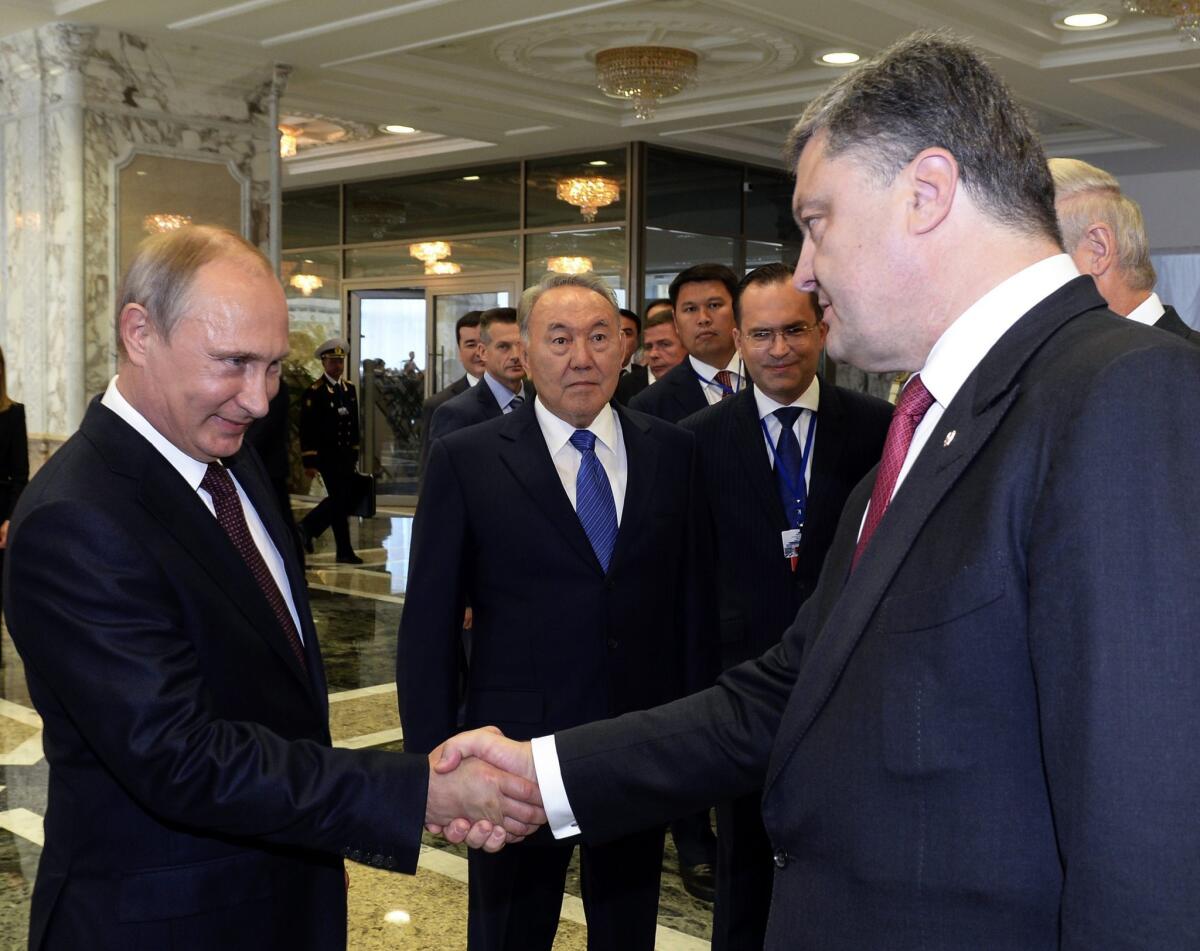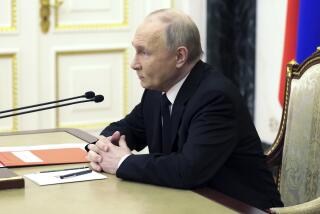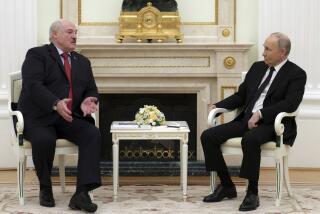Ukraine’s president seeks a truce; Putin proposes his own plan

Collapsing Ukrainian government defenses and a growing public hunger for peace have forced President Petro Poroshenko to seek a truce with pro-Russia separatists at a time when the Kremlin-allied militants have the upper hand in the conflict, analysts said Wednesday.
Russia, too, could benefit from a pause in the fighting that would allow the separatists to solidify their hold on newly seized territory. But Russian President Vladimir Putin appears to be holding out for a humiliating concession of defeat by Kiev.
Poroshenko’s desperate search for a way out of the crisis was apparent in his premature announcement of a “lasting cease-fire” reportedly reached with Putin on Wednesday, a claim the Kremlin disputed.
“Russia cannot physically agree on a cease-fire, as it is not a side in the conflict,” Kremlin spokesman Dmitry Peskov told the RIA Novosti news agency.
Later Wednesday, Putin spoke to reporters during a visit to Mongolia, outlining his own proposals for ending what he portrays as a Ukrainian civil war. His plan calls for a halt to the pro-Russia militants’ offensive and withdrawal of Ukrainian troops from the country’s eastern region.
Ukrainian Prime Minister Arseny Yatsenyuk quickly denounced Putin’s proposal as a plot to “ruin Ukraine and restore the Soviet Union.”
Putin insists that Russia has sent neither troops nor weapons into Ukraine. He casts the conflict as a dispute between a “Kiev junta” and Russian-speaking eastern residents who are “demonstrating” for more autonomy for their regions.
Ukrainian and Western officials accuse Moscow of instigating the crisis and fueling it with infusions of Russian fighters and arms.
Ukrainian government troops appeared on the verge of defeating the separatists last month, after key Russian commanders withdrew and returned to Russia. But after Moscow sent a 280-truck convoy purportedly bearing humanitarian aid into the last separatist-held enclaves and, according to NATO and Kiev, dispatched two columns of tanks into Ukraine’s Sea of Azov region, the tide of the fighting turned.
Government forces have suffered major setbacks over the last 10 days since the Russian incursion opened a new front along the Azov coastal road, drawing Kiev’s troops away from the separatists in Donetsk and Luhansk. Separatist control of the coastal highway would provide a land bridge between the Russian mainland and Crimea, the strategic peninsula seized from Ukraine and annexed by Russia this year.
The Ukrainian army’s withdrawal from the town of Ilovaysk last week signaled a collapse of confidence, said Balazs Jarabik, a scholar monitoring Ukraine with the Carnegie Endowment for International Peace.
“The country is trying to digest the defeat in Ilovaysk,” Jarabik said, citing reports of as many as 700 government troops still trapped behind separatist lines.
More than 2,600 people have died in five months of fighting, including 800 Ukrainian soldiers, defense officials said last week. Russia remains silent about its casualties in Ukraine, burying its dead and treating its injured in secrecy, according to independent news media reports.
Ukrainian society is deeply split over how and whether to end the fighting, and that division is likely to worsen during the campaign for Oct. 26 parliamentary elections, Jarabik said.
“Ukraine may end up with a highly divided parliament that would further weaken central authority,” he said.
Saddling the new Poroshenko leadership with internal discord is a key goal for Putin, who wants instability and proxy control in eastern Ukraine without the economic burdens that would come with annexation, aid Dmitri Trenin, director of the Carnegie Moscow Center, said in a telephone interview from Moscow.
“I don’t think he wants to integrate into an expanded Russia,” Trenin said of the separatist-seized territory. He foresees a drawn-out standoff like the one that has roiled Moldova’s Transnistria region with a Russia-backed separatist occupation for more than 20 years.
Moscow needs a cease-fire to let the latest land grab along the Azov coast become the new status quo, Ukrainian defense analyst Yuri Butusov said.
“Putin keeps escalating the conflict but he does that in stages, launching a series of attacks and taking time to watch out for world and Kiev reaction,” said Butusov.
If a cease-fire is in the offing, embattled government loyalists in the east see no sign of it.
Separatists have retaken control of several villages north of Volnovakha, a town of 24,000 that was the staging ground for the government’s campaign to recover occupied territory in Donetsk, said Mykola Byshkov, regional government chief in the town midway between Donetsk and Mariupol. Kiev officials worry that Mariupol, a port city of 500,000, is the separatists’ next objective.
Russian troops and artillery moved into the area a week ago, allowing the separatists to drive the Ukrainian military into retreat, Byshkov said in an interview at his office.
“Our city’s story will just be another tragic story in this war,” he said, visibly shaken by the rapid collapse of his town’s defenses. “We were protected by the Ukrainian army, but now they have just left us, and the city is wide open.”
Times staff writers Loiko reported from Kiev and Williams from Los Angeles. Special correspondent Sabra Ayres in Volnovakha contributed to this report.
More to Read
Start your day right
Sign up for Essential California for news, features and recommendations from the L.A. Times and beyond in your inbox six days a week.
You may occasionally receive promotional content from the Los Angeles Times.







